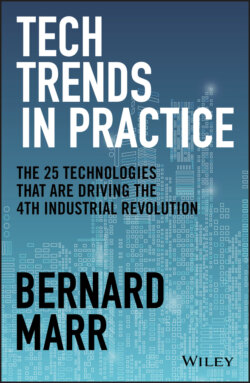Читать книгу Tech Trends in Practice - Бернард Марр, Bernard Marr - Страница 25
What Is the Internet of Things?
ОглавлениеThe rise of smart devices has played a key role in the massive explosion of data (see Big Data, Trend 4) – and is rapidly changing our world and the way we live in it. But, in the IoT, data is created by things, not people, which has given rise to the term “machine-generated data.” How exactly are machines generating data? Typically, it’s when smart devices, gadgets, or machines gather information and communicate that data via the internet – an example being your fitness tracker automatically sending activity data to an app on your phone. (However, as we’ll see later in this section, in the future, devices will increasingly process the data themselves, without having to transmit it for analysis.)
This is all possible because, these days, pretty much everything is getting smarter. It all started with the iPhone, and has since snowballed to include smart TVs, smart watches, and fitness trackers (see wearables, Trend 3), smart home thermostats, smart fridges, smart industrial machinery…even smart nappies that alert you when your baby has, well, done what babies do best. A huge range of devices, machines, and equipment are now fitted with sensors and have the ability to constantly gather and transmit data. Today, even the smallest devices can effectively function as a computer. (However, it’s important to note that an actual computer wouldn’t count as part of the IoT, since the IoT generally refers to everyday objects that we wouldn’t traditionally expect to be able to connect to the internet – like fridges and TVs.)
An IoT device could be as small as a light bulb – smaller, in some cases – or as large as a streetlamp – see intelligent spaces and smart places, Trend 5 – and may be found at home, on our city streets, in our offices, in healthcare settings, in industrial settings, and more. I delve into some of the practical applications of the IoT later in the chapter.
The ability of machines to connect to and share information with each other is a key part of the IoT. These machine-to-machine conversations mean that devices can talk to each other and potentially decide on a course of action without human intervention. For example, manufacturing equipment fitted with sensors could transmit performance data to the cloud for analysis, and based on that data, the system could automatically schedule the equipment for repair and maintenance. (The use of the IoT in industrial and manufacturing settings is often referred to as “Industry 4.0” – smart industry, in other words.)
How big is the IoT? Pretty darn big. The IoT has experienced enormous growth in recent years and the popularity of smart devices shows no sign of slowing down. IHS predicts that 75 billion devices will be connected to the internet by 2025.1 If that number seems hard to fathom, consider this: as of January 2019, Amazon had sold more than 100 million smart devices with Alexa installed.2 That’s just Amazon Echo smart speakers and other Alexa-enabled devices! (Interestingly, many IoT devices are catching on to the power of voice interfaces like Alexa – see Trend 11.)
As well as becoming more ubiquitous, these smart devices are also becoming more powerful, which means that more of the computing can be done on them, rather than having to upload data to the cloud for analysis. This is what’s known as “edge computing” (see Trend 7). With edge computing, data is processed closer to the source of the data and away from the cloud – in theory meaning that your smart fridge could process data itself. It’s relatively early days for edge computing, but it’s predicted to bring big benefits. If you think about it, IoT devices create masses of data – not all of it critical – which can slow down processing and decision-making (fine if you’re just asking Alexa for the weather report, but definitely not fine in, say, a self-driving vehicle). With edge computing (see also Trend 7), networks are less clogged because more processing is happening closer to the data source, which means critical data can be handled much more quickly.
Edge computing is just one of the advances we can look forward to in the IoT, but it’s by no means the only one. As businesses quickly cotton on to the power of the IoT, expect many more exciting IoT-related developments in the coming years.
